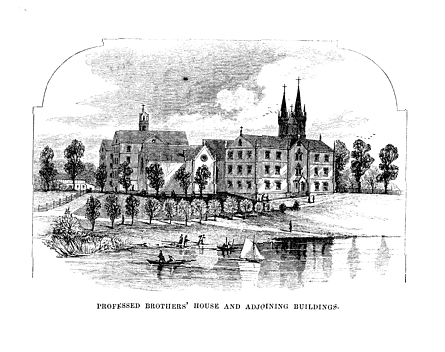Professed Brothers' House


With its little belfry, and its gay flower garden Here the good Brothers reside, whose peculiar fate it is to cultivate the farm of Notre Dame; here reigns the peaceful calm, the neatness, the order, and the superior virtue which must ever mark the abode of men who have made a sacrifice of their lives to God, by their sublime vows, of labor, of obedience, and of charity. Their pretty dwelling forms a real picture when viewed from the wooded hill beyond it, the glassy lake on whose very edge it stands reflecting every line, and light and shadow, and the soft tinted clouds of evening resting ever it like the protecting wings of angels. Towards the south stands the barn with its stores of fodder, its stabling, and its variety of four-footed inmates. There are usually twenty-five horses and thirty cows belonging to the establishment sheltered here, whilst the cellar or basement, eighty by forty-six, is used for the fattening cattle, varying from one hundred and twenty to one hundred and fifty in number, destined to supply the tables of the establishment. These last need not leave their stalls, even to drink, since they are abundantly and easily supplied from the well in the centre of their immense apartment. Without the barn yard is the slaughterhouse -- and also the sugar house, where excellent molasses is made from Sorghum raised on the farm. The lake close by supplies the water so necessary in such a locality. Many ingenious agricultural implements may also be noticed, some of which are the result of the invention and the skill of the Brothers themselves. "Truly," you say, "where the material is so well ordered, the intellectual must be superior." And you are quite right.